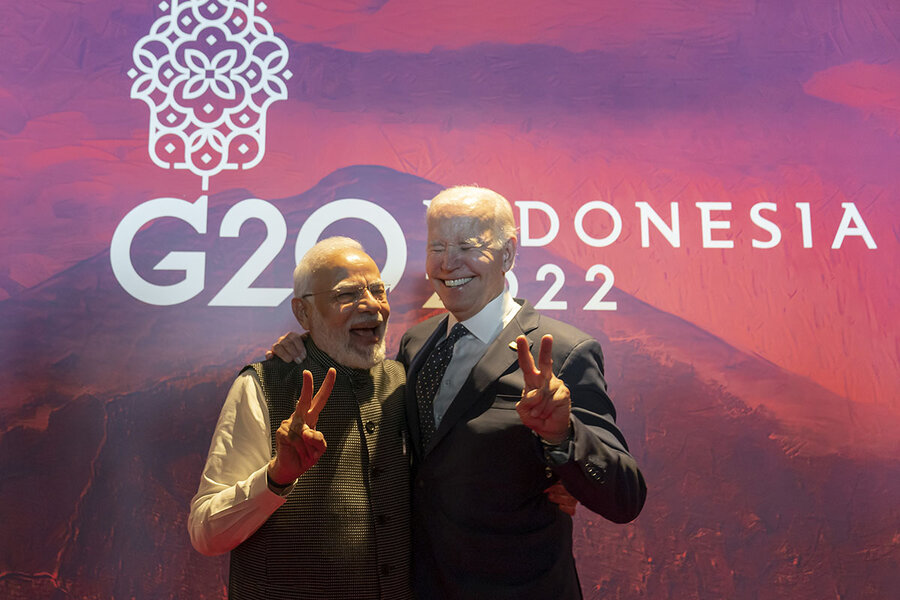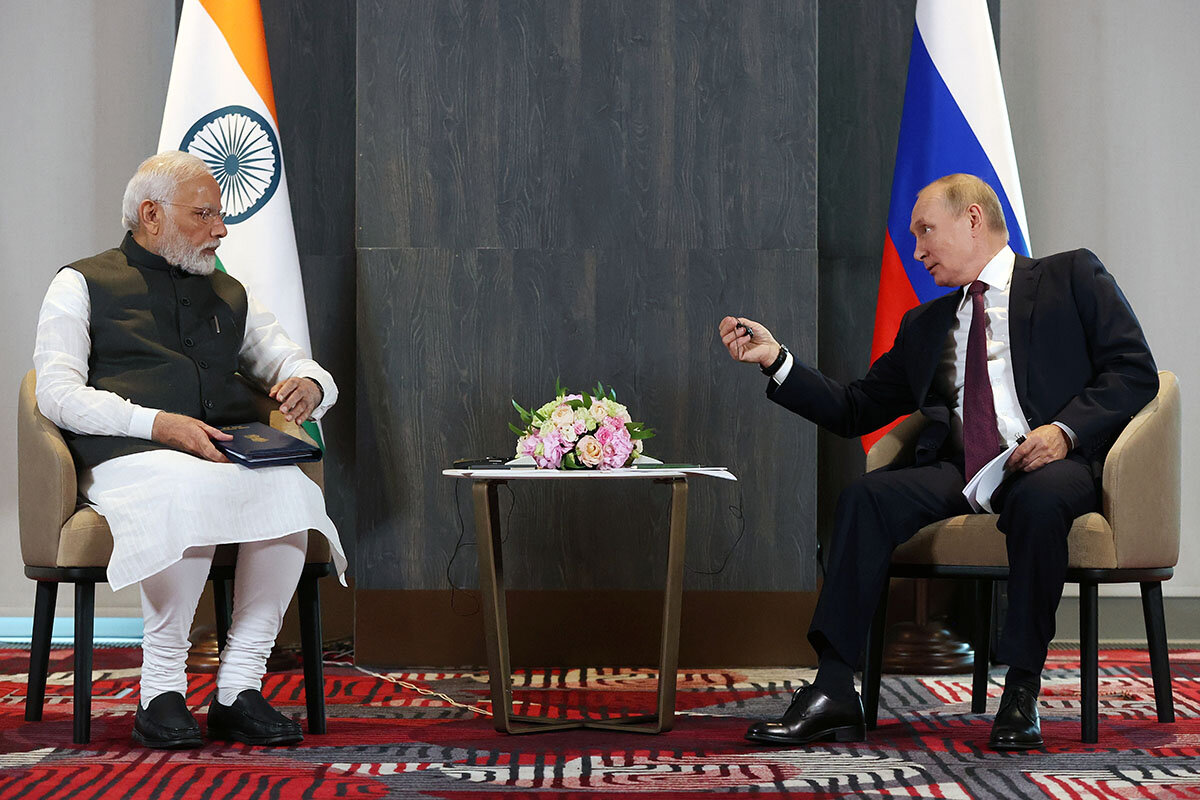To balance China, India charts new foreign policy path
Loading...
| New Delhi
When Indian Prime Minister Narendra Modi used a press conference with Russian President Vladimir Putin in September to publicly criticize Russia’s war in Ukraine – “Today’s era is not of war,” Mr. Modi said – Washington and other Western capitals cheered the show of independence from Moscow.
But Mr. Modi struck an equally independent stance when the Biden administration sought India’s condemnation of Russia over Ukraine at the United Nations. In a similar fashion, India has stood firm as the United States has ramped up pressure on India to stop buying Russian oil. In fact, Russia moved up several notches to become India’s top oil supplier in October, surpassing Saudi Arabia and Iraq.
These events and more suggest how India’s vision of its role in the world is changing, as it rises from its longtime status as the world’s largest democracy – though a poor and underdeveloped one – to a middle economic and political power on the cusp of surpassing China as the world’s most populous country.
Why We Wrote This
A story focused onIndia is charting a new foreign policy path, pivoting away from its “nonaligned” roots and instead fostering multiple partnerships based on national interests – chief of which are growing the economy and balancing powerful neighbor China.
For decades India was a leader of the “nonaligned movement” of developing countries struggling to advance in a post-World War II international system designed by the U.S. and other wealthy Western powers. Its closest ally was the Soviet Union.
But India under Mr. Modi increasingly sees itself as what officials and diplomats describe as an independent “middle power,” partnering with the U.S. on a range of strategic issues based on common goals and values, but aligning itself with no single power or group of countries.
“India is at a flexion point in its international relationships,” says Indrani Bagchi, CEO of the Ananta Aspen Centre in New Delhi and a prominent analyst of Indian foreign policy. It is “pivoting from its legacy relationships, such as with Russia,” to the political and economic “alliances that will serve India most as it seeks to emerge as a global economic power and further the objective of balancing China,” she says.
“In this emerging context India won’t be ‘nonaligned’ or allied with any one country or power,” she adds, “instead it will be ‘multi-aligned’ according to national interests.”
Officials and foreign policy experts say India will deepen partnerships that fit its needs. That means relations with the U.S., which have warmed and strengthened considerably over the past two decades, are likely to continue their upward trajectory.
“India is trying to create an enabling environment for its own transformation,” says Shivshankar Menon, a former Indian ambassador to China who served as national security adviser to former Prime Minister Manmohan Singh. “It’s a big job, and we can’t do it without good relations with the United States.”
Opportunity to lead
At the same time, India will try its hand at leading when it believes it can make a difference.
India’s presidency over the next year of the G-20 group of major and middle economies is an example of this brand of leadership, experts say.
Mr. Modi will use the coming year in the global diplomatic spotlight to pursue goals ranging from climate justice and mitigation to equitable green economic development from the perspective of the “global south” economies, Indian observers say. He also sees the G-20 presidency as an opportunity to shape global perspectives of India, they add.
But some say this approach will include a dose of realism and self-awareness of the limits a rising but still developing power like India faces internationally.
“Modi wants to boost India’s international stature, but at the same time he knows that India is not at the point either politically or economically of assuming the role of a great power,” says Pramit Chaudhuri, who heads the Eurasia Group’s India activities in New Delhi. “That means focusing on the international issues that matter most to India, like China and climate change, while downplaying the issues where India realizes it doesn’t have the clout or diplomatic bandwidth to make a difference.”
He notes, for example, that when the Group of Seven leading industrial nations asked India to mediate between Ukraine and Russia, Mr. Modi declined – recognizing, Mr. Chauduri says, that India was unlikely to succeed in such a high-stakes role.
“India wants to position itself lower down the rungs, away from high-profile roles,” Mr. Chaudhuri says. As evidence, he points to how Indian External Affairs Minister S. Jaishankar has over recent months “reframed his own description of India from ‘leading power’ to ‘aspiring to be a leading power.’”
Coalition of the willing
India’s focus on alignments that can serve its purpose while not boxing it in makes the Quad grouping of Indo-Pacific powers – the U.S., Japan, Australia, and India – a particularly attractive partnership for New Delhi, Indian experts say. A relative newcomer to global partnerships, the Quad was formalized in 2007 after the four countries worked together successfully on the 2004 Aceh tsunami.
“In this context where ‘multi-alignment’ is the new mantra, the Quad is the right fit because it offers the flexibility India wants,” says Ms. Bagchi. “For India, the overarching draw of the Quad is its ability to collectively counter China,” she says. But unlike a constraining alliance, the Quad also offers India the “flexibility” that suits it, she adds.
The Quad has 26 working groups that members participate in or not according to their strengths and interests, an organizational model she says works well with India’s vision of its international role.
“It’s what George Bush used to call ‘coalitions of the willing,’” Ms. Bagchi says, “and that’s the kind of ‘coalition’ India is comfortable with as a rising power at its stage of development.”
With its focus on maritime security in the Indo-Pacific region and freedom of maritime navigation, the Quad fits with India’s aim of balancing China in the region. India on its own doesn’t give China much pause in its regional pursuits, Indian analysts say, but India teamed up with the U.S. and the other Quad partners is more to reckon with.
“China sees India as too poor, too undisciplined, too chaotic to deal with as a peer power, but that has changed as we have moved closer to the United States, and to Japan,” Ms. Bagchi says. “As India has warmed to the U.S. and joined the Quad, the Chinese have taken full notice.”
Goals and values
Another factor explaining India’s warming towards the U.S. is a youth population more drawn to the values of freedom and individual merit than to the collectivist ideologies popular in post-independence India. Thus one survey this year showed Indian youth anticipate a growing shift in India away from traditional partners like Russia towards closer links with the U.S. and other Western countries.
During a visit to Washington in September, External Affairs Minister Jaishankar extolled the strengthening and warming of U.S.-India relations over recent decades and credited ever-closer ties between the two countries’ people with providing the foundation for the growing friendship.
India is also tailoring its international partnerships to take full advantage of Western economies’ accelerating decoupling from China as their principal economic partner.
India’s GDP may only be one-fifth of China’s currently, but Indian officials thrill to contrasting their country’s growing young and educated population with China’s aging population.
And global tech giants and others have taken notice. In September, Apple shifted some of its iPhone 14 production to a Foxconn plant in Chennai, India. In a report the same month, J.P. Morgan projected that Apple’s twofold goal of meeting smartphone demand in the booming Indian market while also shifting manufacturing away from China will result in India producing about 25% of all iPhones by 2025 – up from about 5% today.
For Mr. Chaudhuri, India understands that dampening China’s intentions of becoming the Indo-Pacific region’s dominant power will require India becoming an economic, political, and military power to be reckoned with.
“India now realizes that the best way to challenge China’s regional goals is to keep it wary of you and convinced that you can match them if they push,” he says.
And that, analysts say, explains Mr. Modi’s dual focus on growing India’s economy and its international partnerships with like-minded powers that count with Beijing.
“India and the U.S. see pretty much eye to eye when it comes to the importance of counterbalancing China,” Mr. Chaudhuri says. “That goes a long way in explaining the upward trajectory in U.S.-India relations.”







